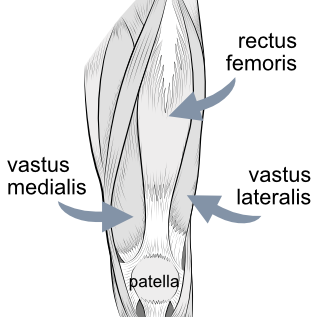There are two main muscle groups above the knee - quadriceps at the front and hamstrings at the back. Three main muscles make up the calf - gastrocnemius, soleus and plantaris.

Illustration of the quadriceps muscle group (vastus intermedius lies underneath the rectus femoris).
Which muscles straighten the knee?
The main muscle that straightens the knee is the quadriceps. 'Quadriceps' means 'four heads', as this muscle has four parts that join together at the bottom into a common tendon. These are the 'lap' muscles.
What is the extensor mechanism?
The extension muscles are linked to the patella via a soft tissue network of fascia. The quadriceps tendon attaches to the patella at its upper end and the patellar tendon attaches the patella to the tibia. The whole complex works together and is known as the 'extensor mechanism'.
Which muscles bend the knee?
The hamstrings muscles bend the knee. The hamstrings group consists of three individual muscles, and are so-called because of the long tendons at the lower end, which a butcher uses to string up a ham for smoking.
Knee muscles from the front
The quadriceps muscles ('quads') dominate the front of the knee, and are the muscles making your 'lap'.
This next illustration shows how the rectus femoris reaches all the way from the pelvis and hip to the tibia. The other heads originate on the femur. Physiotherapists tend to focus a lot of attention on the vastus medialis, especially at the lower end where the muscle fibres are more oblique. Here the muscle is referred to as the vastus medialis obliquus or VMO. Weakness in the VMO is considered to be a factor in failure to regain a good extension, although there is quite a lot of controversy about this.
'Quadriceps' means '4 heads' - the 'muscle' is actually four separate muscles that work together to straighten (extend) the knee. The muscles, quads tendon, patella, patellar tendon and the fibrous retinaculum at the sides of the patella are together called 'the extensor mechanism'.
The individual muscles heads of the quadriceps include:
- vastus lateralis
- vastus intermedius (underneath the rectus femoris, so you don't see it here)
- vastus medialis
- rectus femoris
At the lower end the rectus femoris attaches directly to the patella via the quads tendon, which itself attaches to the tibia via the patellar tendon. The area of attachment on the tibia is the tibial tubercle (or tibial tuberosity). The vastus medialis and lateralis are also linked to the patella, but this is via the lower end splaying out into a fibrous network called 'the retinaculum'.
Knee muscles from the back
This is an illustration of the back of a right knee.
The main muscles at the back of the knee are the hamstrings muscles at the back of the thigh and the gastrocnemius muscles at the back of the calf.
The three hamstring muscles are the biceps femoris, the semimembranosus and the semitendinosus muscles.
In the calf you can see the bulky gastrocnemius muscle. Under it lies the soleus muscle (not visible on image). The tendons of the two combine to form the strong Achilles tendon at the back of the ankle.
The long thin tendon of the semitendinosus muscle is frequently 'harvested' by the surgeon for use in cruciate ligament reconstruction. It is commonly referred to as one of -the 'pes' or 'pes anserinus' tendons (semitendinosus, gracilis, sartorius) which insert on the medial (inner) aspect of the tibia in a compound tendon which looks a bit like a goose's foot (hence the latin name 'pes anserinus').
The 'gracilis' muscle is another whose tendon is often used, together with that of semitendinosus, to make a replacement cruciate ligament.The gracilis muscle is, however from a different group of muscles known as the 'adductors' and is not technically a hamstrings muscle.